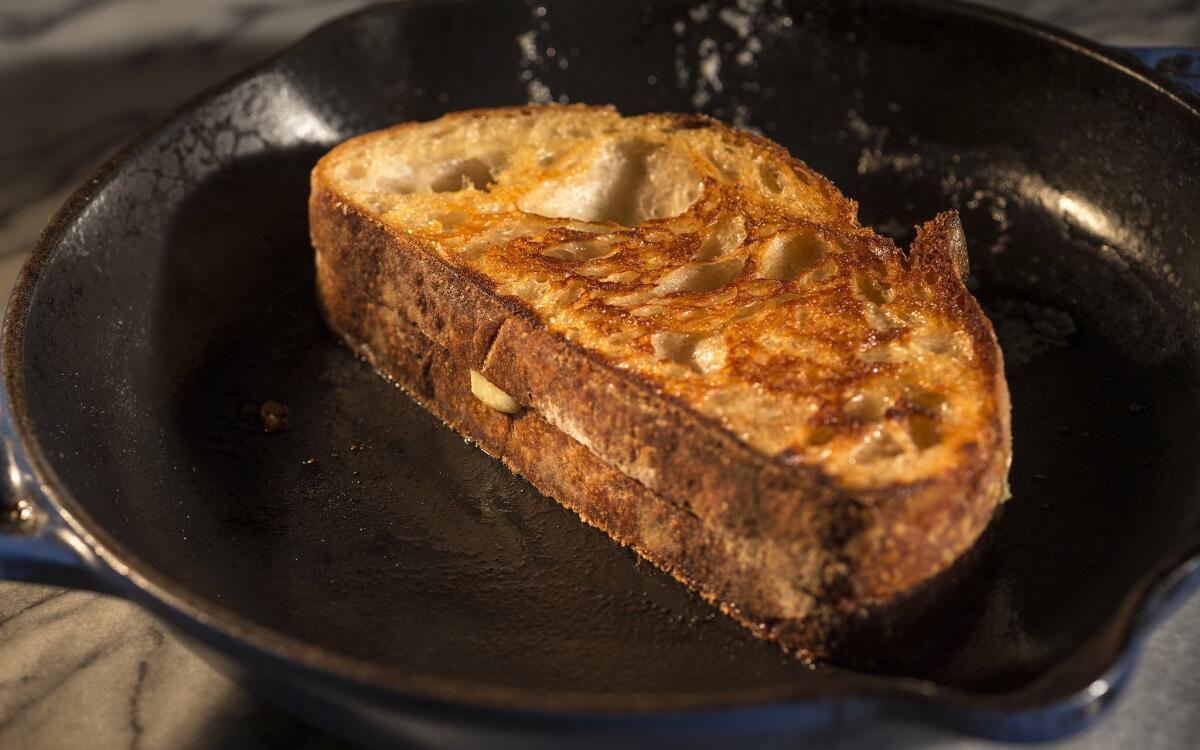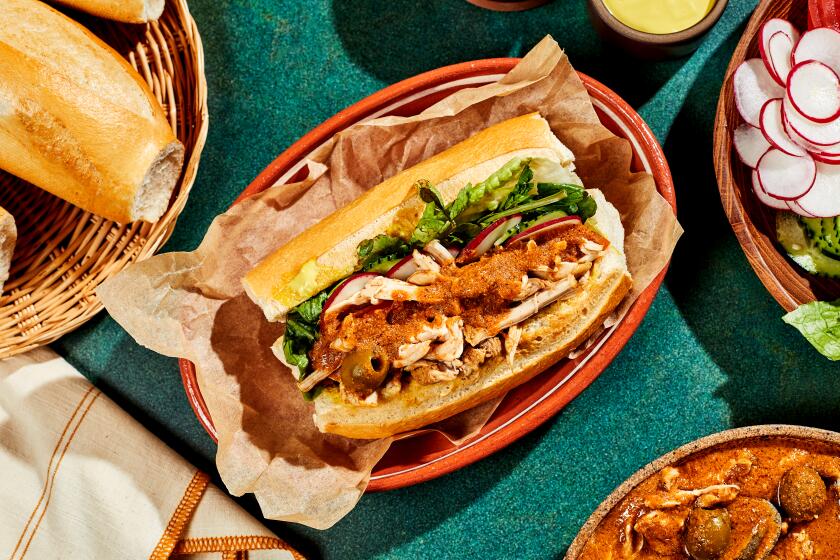Classic grilled cheese

Bread or wine? It’s a question Brandon Sparks-Gills wrestled with for a few years. He was fascinated by both, and, for a time in Colorado, he split his days between baking and viticulture. That meant getting up in the middle of the night to be at his baking job at 2 a.m., then driving an hour in the afternoon to work at a vineyard beneath the sandstone cliffs of Cortez.
Readers, he chose wine. And since 2005 he has been a partner, with brothers John and Steve Dragonette, in Dragonette Cellars in the Santa Ynez Valley. His two passions come together when Sparks-Gills gets in the kitchen to make a favorite lunch: grilled cheese sandwiches. And, yes, he pairs them with his wines.
On a recent afternoon at his house in Solvang, he showed off his favorites. Rob Kabeary, the baker he worked for at Bread in Durango, Colo., had sent him a giant loaf of pain de campagne and a shiny sourdough oval, bubbled on the outside. He’d also picked up some loaves from his favorite local baker, Well Bread in Los Alamos, a smaller round of pain au levain and a rustic rye.
Santa Ynez doesn’t have much in the way of cheese shops, so he had shopped at Whole Foods. For a classic grilled cheese, he likes an English cheddar or a Tillamook from Oregon, so he had found Ashley Chase Estate Seaside Cheddar there and a 15-month Tillamook from Oregon. He also picked up a cave-aged single-origin Gruyère, something he’d never seen before.
They’d just bottled the 2013 Dragonette rosé the day before, but because of the wine’s high acidity, Sparks-Gills uses only a minimum of sulfur — so no waiting to drink this one. It’s scented with white peaches and apricot, and has a refreshing minerality. Firing up the gas grill, he quickly grilled half-inch-thick slices of sourdough for crostini. The topping? Point Reyes Blue mixed with fresh goat cheese, quartered dried white figs he’d soaked in Sauvignon Blanc for a couple of hours and toasted pine nuts. Sometimes he adds fresh thyme or basil.
By this time, the Dragonette brothers have arrived. They opened a bottle of their 2013 Happy Canyon Sauvignon Blanc. The rosé was drinking beautifully; the lush Sauvignon Blanc worked so well with the blue cheese and the sweet funk of the figs.
Now it was time to get serious. But first Sparks-Gills had to make one of his “freshies,” sandwiches made with pain au levain, sweet red peppers he roasted that morning, a smear of pesto and a thick slice of fresh mozzarella. He drizzled the outside with olive oil and browned it on the grill.
Next up: the 2012 Sauvignon Blanc from Vogelzang vineyard, which has more depth and minerality, and his classic grilled cheese made with that sharp English cheddar on Well Bread’s levain. The cheese was just melting at the edges, its flavor blooming rich and tangy. It loved the Sauvignon. He’d also made another with aged Tillamook, which is just a bit rounder and a touch less intense. The mustard was some special stuff he buys once a year from the Seattle online shop Garagiste, so good it’s allocated like wine.
Which Sauvignon Blanc worked with which sandwich? Was the Santa Rita Hills Pinot a better match because of the way the bright berry fruit lighted up the cheddar? Of course, nobody agreed, because in fact all of these wines are quite wonderful with grilled cheese sandwiches — though the whites may have the edge.
It’s just bread, cheese and butter, but better than many a restaurant meal.
“One of the things I love about bread,” said Sparks-Gills, “is that even with something this simple, depending on the degree to which you grill or cook it, the flavor profile shifts radically.”
One more sandwich to go — Well Bread’s rye with that nutty, cave-aged Gruyère. A jar of McClure’s garlic pickles. We all agreed the Pinot Noir or the 2012 Dragonette Seven Syrah worked best. But why choose?
Four sandwiches, four glasses of wine later, Sparks-Gills passed out homemade chocolate chip cookies.
The guy can bake cookies too. Nice.
Place the sliced cheddar between the bread slices to assemble the sandwich.
Heat 1 to 2 tablespoons butter in a nonstick sauté pan over medium-high heat until melted. Place the sandwich in the pan and cook until one side is toasted to a rich golden color, then lift the sandwich out of the pan. Add additional butter to the pan, if needed, and when it is melted, place the sandwich back in the pan, untoasted side down. Cook until toasted and a rich golden color, then remove, slice and serve.
Get our Cooking newsletter.
Your roundup of inspiring recipes and kitchen tricks.
You may occasionally receive promotional content from the Los Angeles Times.















